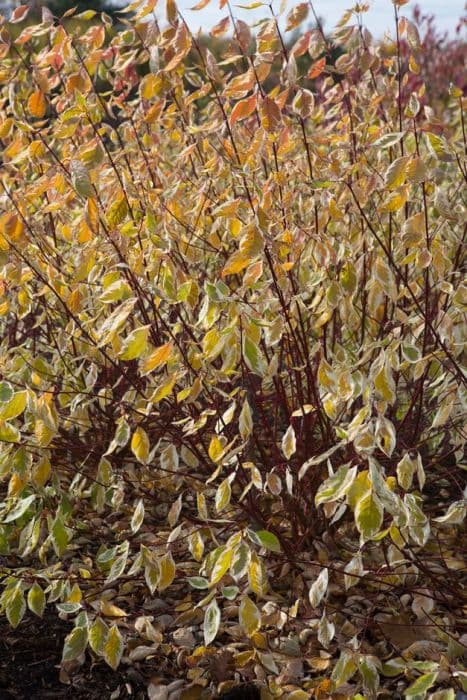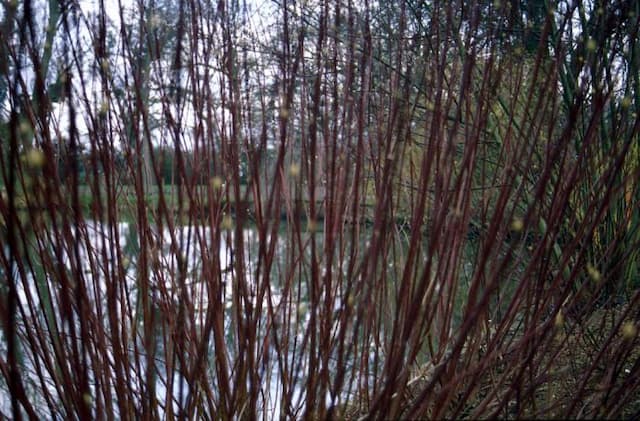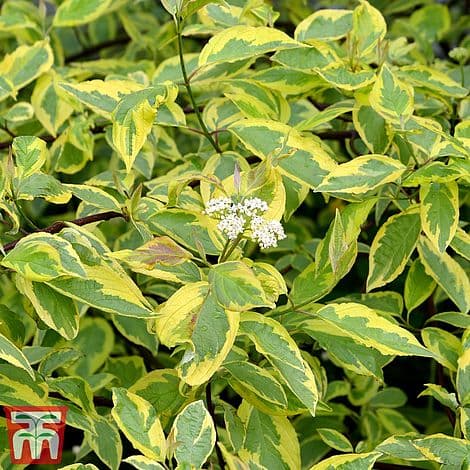Siberian dogwood Cornus alba 'Siberian Pearls'

ABOUT
Siberian Pearls, a cultivated variety of the Red Twig Dogwood, is a deciduous shrub known for its stunning winter appeal. During the growing season, its leaves are green with a somewhat ovate shape, often displaying modest white flowers that give way to clusters of white, pearl-like berries in the fall and winter. These berries are quite attractive to birds and wildlife. The foliage can turn shades of reddish-purple in the autumn, providing aesthetic interest through the changing seasons. What makes the Siberian Pearls particularly noted is its striking red branches that become intensely colorful in the winter months after the leaves have fallen. These vivid red stems create a stark and beautiful contrast against snowy landscapes or grey winter skies, making it a popular choice for gardeners looking to add winter color to their gardens. The plant can spread by suckers and contribute to a dense thicket if not managed properly.
About this plant
 Names
NamesSynonyms
Siberian Pearls Dogwood, White Dogwood, Tatarian Dogwood.
Common names
Cornus alba 'Siberica'.
 Toxicity
ToxicityTo humans
The plant commonly known as Tatarian Dogwood is generally not considered highly toxic to humans. However, ingesting parts of the plant, particularly the berries, might lead to mild symptoms such as nausea, vomiting, or diarrhea. It is not typically associated with severe poisoning or life-threatening consequences, but it is advisable to avoid consuming any parts of the Tatarian Dogwood.
To pets
Tatarian Dogwood is also not considered highly toxic to pets. If pets consume parts of the plant, they might experience mild gastrointestinal upset, such as vomiting or diarrhea. While it is not seen as dangerously poisonous, it is still recommended to prevent pets from ingesting parts of the Tatarian Dogwood to avoid any potential discomfort or minor health issues.
 Characteristics
CharacteristicsLife cycle
Perennials
Foliage type
Deciduous
Color of leaves
Green
Flower color
White
Height
6 feet (1.83 meters)
Spread
5 feet (1.52 meters)
Plant type
Shrub
Hardiness zones
3
Native area
Asia
Benefits
 General Benefits
General Benefits- Ornamental Appeal: Bright red stems provide striking winter color, adding aesthetic value to landscapes.
- Seasonal Interest: Offers year-round interest with white spring flowers, summer fruits, and colorful autumn leaves.
- Habitat Support: Produces berries that are a food source for birds and other wildlife.
- Erosion Control: Its root system helps stabilize soil, preventing erosion on slopes or banks.
- Low Maintenance: Requires minimal care once established, making it a convenient choice for gardeners.
- Hardy Nature: Tolerates harsh weather conditions, including cold winters, characteristic of its namesake region, Siberia.
- Adaptable Growth: Thrives in a variety of soil types and pH levels, requiring little soil amendment.
- Privacy Screen: Dense growth habit can be used to create natural privacy screens or hedges.
- Pollinator Friendly: Flowers attract bees and other pollinators, supporting local ecosystems.
 Medical Properties
Medical Properties- This plant is not used for medical purposes.
 Air-purifying Qualities
Air-purifying QualitiesThis plant is not specifically known for air purifying qualities.
 Other Uses
Other Uses- Crafting Walking Sticks: Cornus alba's strong, straight stems can be harvested and cured to make durable walking sticks or canes.
- Plant Supports: The sturdy branches can be used in the garden to create natural supports for climbing plants such as peas or beans.
- Winter Interest: Cornus alba 'Siberian Pearls', with its bright red stems, is used in landscaping to add color and visual interest to winter gardens.
- Wildlife Shelter: Dense thickets of this shrub can provide shelter and protection for birds and small wildlife during harsh weather.
- Natural Hedges: The fast-growing nature of this plant allows it to be used to quickly establish hedges for privacy or windbreaks.
- Winter Flower Arrangements: The colorful branches are popular in floral arrangements, especially during the winter season when color is scarce in the garden.
- Photography: Vibrant against snowy backdrops, Cornus alba is a common subject for winter and nature photographers seeking stark color contrasts.
- Educational Tool: This plant is used in schools or educational programs to teach pruning techniques, as it responds well to being cut back.
- Erosion Control: The extensive root system of Cornus alba helps to stabilize soil on slopes and prevent erosion.
- Soil Improvement: As a pioneer species, it can improve the soil conditions in degraded landscapes, making it possible for other plants to establish themselves in the future.
Interesting Facts
 Feng Shui
Feng ShuiThe Red Twig Dogwood is not used in Feng Shui practice.
 Zodiac Sign Compitability
Zodiac Sign CompitabilityThe Red Twig Dogwood is not used in astrology practice.
 Plant Symbolism
Plant Symbolism- Purity: The white blossoms of the Red Twig Dogwood, which Cornus alba 'Siberian Pearls' is a cultivar of, often symbolize purity and innocence.
- Hope: As the plant reblooms and the red stems stand out in winter, it represents hope and the promise of renewal.
- Resilience: This hardy shrub, able to withstand Siberian conditions, symbolizes strength and the ability to thrive despite challenges.
- Protection: Dogwoods, in folklore, are often associated with safety and the warding off of negative energy, symbolizing protection.
- New Beginnings: The plant's vigorous growth and new shoots in spring represent fresh starts and new opportunities.
 Water
WaterThe Tatarian Dogwood, commonly known as Cornus alba 'Siberian Pearls', should be watered deeply and thoroughly to ensure that the water reaches the deep roots. During the growing season, watering once a week with approximately 1 to 1.5 gallons of water is recommended, depending on the weather conditions. In hot and dry periods, increase the frequency to twice a week. During the dormant season in winter, reduce watering to every two weeks or less, depending on soil moisture. Always check the soil moisture before watering and avoid overwatering, as this can lead to root rot.
 Light
LightThe Tatarian Dogwood thrives best in full sun to partial shade conditions. Ideally, planting it in a spot that gets at least 4 to 6 hours of direct sunlight daily is beneficial for the health and flowering of the plant. However, it can also tolerate and adapt to light shaded areas, making it versatile in terms of lighting placement in a garden.
 Temperature
TemperatureFor the Tatarian Dogwood, temperatures between 50°F and 75°F are ideal for its growth and development. While it can survive temperatures as low as -30°F during dormancy in winter and withstand occasional spikes above 80°F in summer, prolonged exposure to extreme temperatures should be avoided.
 Pruning
PruningThe Tatarian Dogwood should be pruned to maintain its shape and encourage vibrant stem color, which is most notable in the winter months. The best time to prune is late winter or early spring before new growth starts. Prune about one-third of the oldest stems to the ground yearly, and trim out any broken, diseased, or crossing branches to maintain air circulation and plant health.
 Cleaning
CleaningAs needed
 Soil
SoilRed Twig Dogwood 'Siberian Pearls' prefers a soil mix with good drainage, consisting of loamy soil, peat, and some sand or perlite. The ideal soil pH for this shrub is between 5.5 and 7.5.
 Repotting
RepottingRed Twig Dogwood 'Siberian Pearls' does not typically require frequent repotting as it is a larger shrub best suited for outdoor planting. However, it may need replanting every few years if growth is limited by the pot size.
 Humidity & Misting
Humidity & MistingRed Twig Dogwood 'Siberian Pearls' is adaptable to a wide range of humidity conditions and does not require any special humidity levels when grown outdoors.
 Suitable locations
Suitable locationsIndoor
Ensure bright light, cooler temps, and moderate watering.
Outdoor
Full to part sun, moist soil, and mulch to protect roots.
Hardiness zone
2-7 USDA
 Life cycle
Life cycleCornus alba 'Siberian Pearls,' commonly known as Tatarian dogwood, begins its life cycle with seed germination, generally occurring in spring as temperatures rise and daylight increases. After germination, the seedling grows through the vegetative stage, developing a root system and foliage during the growing season. As the plant matures, it enters a period of rapid growth, where both roots and stems extend, and the characteristic red bark develops. Following the establishment, the Tatarian dogwood enters the reproductive phase, producing clusters of white flowers by late spring or early summer, which then give way to clusters of white to pale blue berries, or drupes, by late summer or fall. As temperatures drop and days shorten in the autumn, the plant begins to enter dormancy; leaves turn to vibrant fall colors before dropping, with the plant conserving energy for the winter. With the arrival of the next spring, the cycle recommences, with new growth sprouting from the plant's established framework.
 Propogation
PropogationPropogation time
Late Winter-Early Spring
Cornus alba 'Siberian Pearls', commonly known as the Siberian Dogwood, can be propagated most effectively through hardwood cuttings. This method typically takes place during the plant's dormant season, which is late fall to early winter. To do so, select healthy, pencil-sized stems from the current year's growth and cut them to lengths of 6 to 8 inches (15 to 20 centimeters). Ensure each cutting has several buds. Dip the cut end in rooting hormone powder to encourage growth, then plant the cuttings in a mix of equal parts peat and perlite or sand, making sure at least two buds are buried beneath the soil surface. Place the cuttings in a cold frame or somewhere that has diffused light and ensure the medium remains moist but not waterlogged. Roots will develop over the winter months, and by spring, the cuttings can be potted up or planted out in their final location.









